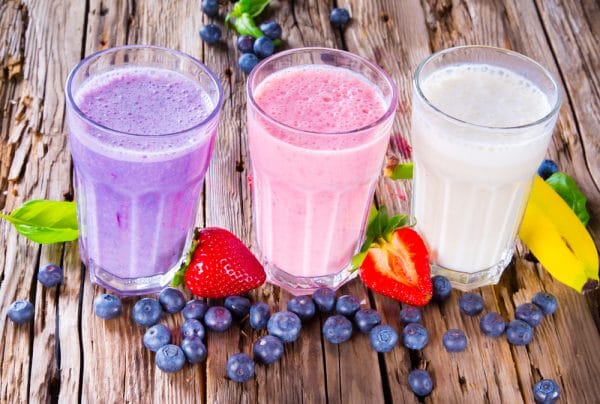If you’re pregnant and have gestational diabetes, you know that you need to take extra care of yourself – including making sure you’re getting enough protein. Protein shakes can be a great way to make sure you’re getting the protein your body needs. But with so many different types of protein shakes on the market, how do you know which one is right for you? Read on for a breakdown of the best protein shakes for gestational diabetes mamas!

With Gestational Diabetes, eating enough protein is really important – but boy, can it be hard!
Protein shakes and smoothies were my saving grace. They were easy to eat and keep down, and it made it a lot easier to reach my protein goals.
It’s really easy to go overboard with smoothies, though, and end up with way too many carbs. All of these are lower in carbs. I always had good numbers after that.
A few things to keep in mind:
- Not everyone can handle bananas. I never had an issue – I like them because they add creaminess, but I would only add about 50 grams to my smoothies. If you can’t handle bananas, you could try avocado for the added creaminess (and good fat!). You can also just omit it entirely.
- If you need a few more carbs, you can always add a couple of tablespoons of rolled oats.
- Most GD moms can’t have a lot of cow’s milk, so I suggest finding another kind of milk for your smoothies. I have good luck with unsweetened almond milk – the carbs are generally really low
- Pay attention to the carbs on your protein powder and the ingredients. Some proteins have a lot of bad ingredients in them. Orgain does have more total carbs than some of the protein powders I have used in the past, but the ingredients are great, and there’s a lot of fiber (which helps you digest it slower). The serving size is for two scoops, but if you think the carbs are too high, just use one scoop!
Need more ideas for food? Check out this post – 60+ Gestational Diabetes Diet Menu Ideas
What to Look For in a Diabetes Friendly Protein Powder
There are a lot of protein powders that are just filled with junk out there – and you want to avoid them whether you are pregnant, have Gestational diabetes, or not!
While you don’t have to find a protein powder that is specifically for pregnancy, I do recommend finding one that is low in sugar and carbs and has ingredients that you recognize and can pronounce. I would also look for a one that has a good amount of fiber in it.
Fiber can help you digest your food more slowly and prevent blood sugar spikes. Of course, as you try a new protein powder or shake, make sure you monitor your blood sugar to see how your body reacts.
Because some people have issues with cow’s milk causing a spike in blood sugar, a plant-based protein powder may be more appropriate for some people.
Best Protein Powder for Gestational Diabetes
These are my top picks for protein powders. I am going to start out with the two brands that I personally use and love, and then I will share others I have found that have fantastic reviews as well.
Top Overall Choice – Just Ingredients
Karalynne from Just Ingredients is incredible, and she’s made it her mission to provide clean products – including protein powder – to the world.
She released this protein powder last year, and I watched closely as she went through the process of developing it. To say that she went to the ends of the earth to get the cleanest, best ingredients is not an understatement. I don’t think you’ll find a cleaner product out there, and it tastes delicious.
This is my top pick due to it being 100% clean and natural, no sugar, and low in carbs while high in protein. It’s perfect for pregnancy and GDM mamas.
Chocolate and chocolate coconut are always available for sale. I absolutely love the chocolate coconut flavor. She also releases seasonal flavors, such as Pumpkin Spice and Chocolate peppermint.
And it’s not protein, but if you are missing hot cocoa, the hot cocoa is really tasty and should be tolerated fine by most GDM moms.
It is a whey-based protein, but it is 100% grass-fed, denatured whey protein isolate.
Here is a basic overview of the nutrition:
- Protein from Five Sources
- Non-denatured 100% Grass-fed Whey Protein Isolate from New Zealand
- Organic Pea Protein
- Organic Pumpkin Seed
- Organic Chia Seed
- Collagen
- Free of sugar, gluten, and artificial sweeteners
- Depending on the flavor, it has between 140 and 160 calories per serving
- 4 grams of fat
- 3 carbs
- 3 grams dietary fiber
- 24 grams of protein
You can get 10% off with the code TBM
Best Pregnancy Specific Protein – Ritual
Ritual is another popular brand that has come to the market. I have used their prenatal and women’s multi-vitamin, and I really like them. It is specifically designed for pregnancy and breastfeeding.
This is a plant-based protein powder, which may make it appealing to more people. It also includes 250mg of choline, which is really important to pregnant mothers.
They only have one flavor, but I feel like they’ve put a lot of work into perfecting the one protein that they have. It is a vanilla-based protein with some undertones of caramel.
Here is an overview of nutrition.
- 115 calories
- 30 grams protein (pea protein based)
- 4 grams carbs
- 2 grams fat
- 3 grams fiber
- 0 grams sugar
Most Variety – Clean Simple Eats
Clean Simple Eats is the brand that I used throughout my GDM pregnancy. I love that it has so many different flavors, has clean ingredients, and is just overall very tasty.
They also have TONS of other products, and I absolutely love their cookbooks. Almost all of the recipes are GDM-friendly, and they all have the nutritional facts on them. They also have their mobile app, which you can pay a subscription for to get access to all their recipes. The free version has some, too, so you can check it out to see if it’s something you want to subscribe to.
This one does have higher carbs than some others, so if you really have trouble staying within your carb limit, that is something to keep in mind.
Here is the nutritional overview (may vary from protein to protein)
- 20 grams protein
- 9 carbs
- 1 gram sugar
- 1 gram fiber
- 0 grams fat
- Sweetened with stevia and monk fruit
- Grass fed, Whey-based protein
- Includes an enzyme blend to help make it easier to digest
You can save 10% with the code TBM10
Needed
Needed is a great brand that has a variety of products to support you through pregnancy. My IBCLC mentor often recommends their prenatal and post natal vitamin.
The protein powder they sell is a collagen protein powder. Collage is important for pregnancy and postpartum healing. It is also is designed to help promote good gut healthy for both mom and baby.
They’ve also designed it to help with blood sugar and weight management, which I thought was awesome. It is flavorless, so you can mix it into just about anything.
Here are the nutritional overview:
- 80 calories
- 14 gram protein
- 15 grams collagen
- Made with grass-fed, pasture-raised, and hormone-free bovine
- It’s designed to be paired with their other lines of prenatal and postnatal products
Baby Booster
This is another protein powder that is designed specifically for pregnancy. It is a vegetarian-based powder, and it includes DHA, folate, and other important vitamins for pregnancy.
Be sure to compare its ingredients against your prenatal vitamin to make sure you aren’t doubling up on too many vitamins!
It is caffeine free, gluten-free, soy-free, and free of preservatives and artificial sweeteners. They claim it’s one of the best tasting protein powders on the market. It has a lot of great reviews, and it is a little less expensive than some of the other brands I have mentioned.
Here is the nutritional overview:
- 120 grams protein
- 2.5 grams fat
- 5 grams carbs
- 1 gram fiber
- 2 grams sugar
- 20 grams protein
- Sweetened with stevia and monk fruit
- Comes in vanilla and chocolate
Orgain
Orgain is a very popular brand of protein powder. I’ve really enjoyed it myself, and I had it sometimes with my GDM pregnancy. It is widely available in grocery stores, online, and stores like Costco.
I like the different flavors taht they have, and it does taste very clean. They also have ready-to-drink shakes that are really convenient on the go. A lot of moms with GDM turn toward the Premier Protein ready-to-drink shakes, however, those don’t have the best ingredients. If you want an alternative to that, definitely look into Orgain.
The recipes that I share below were created with Orgain protein powder (though you can really substitute with any kind you want!).
They have a variety of different types of protein powders and flavors. I would keep in mind that this one has quite a few more carbs than some of the other brands I mentioned. If you are struggling with carbs, it might not be the best option for you. However, I included it because it’s convenient, clean, and they have the read-to-drink shakes.
Here is the nutritional overview (this will vary depending on what kind you get – I am basing this on their chocolate powder)
- 150 calories
- 21 grams protein
- 15 grams carbs
- 2 grams fiber
- 5 grams Erythritol
You can save 25% with the code CLARKS25.
Gestational Diabetes Smoothies Recipes

While you can easily mix protein powder with water or milk of choice, I like to add other ingredients. With Gestational Diabetes, you DO need to be more careful with the fruits that you add, but I had no issue with any of these shakes when I was pregnant.
Chocolate Peanut Butter
- 1 cup unsweetened almond milk
- 1-2 scoops chocolate peanut butter protein powder
- 50 grams banana
Almond Joy
- 1 cup unsweetened almond milk
- 1-2 scoops chocolate protein powder (the chocolate coconut flavor from Just Ingredients would be delicious)
- 1 tablespoon coconut
- 50 grams banana
Peach Smoothie
- 1 cup unsweetened almond milk
- 1/2 cup frozen peaches
- 1-2 scoops vanilla protein powder
Berry Blast
- 1 cup unsweetened almond milk
- 1/2 cup mixed berries (I like the Kirkland brand)
- 1/2 banana
- 1-2 scoops chocolate or vanilla protein powder
PB and J
- 1 cup unsweetened almond milk
- 1-2 scoops of peanut butter protein powder
- 1/2 cup berries
- 50 grams banana
I hope that this was helpful! Please let me know if you have any questions!
Ohioren Aigbokhaevbo says
Great tips…I couldn’t have agreed more.
Eating healthy and regular exercise is a good way to manage gestational diabetes.
Chelsea Johnson says
I’m so glad I never had gestational diabetes while I was pregnant! I had to take the three-hour test once, but I passed! But I’m definitely sharing this for mamas who don’t pass! Thanks for such a great resource!
Katie says
Thanks! It’s definitely not a fun diagnosis, but it’s good when you have helpful resources at hand!